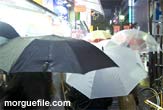Urban Irrigation Has Increased Phoenix Area's Rainfall

Phoenix and other cities in arid regions create artificial conditions that alter rainfall patterns, a new study finds.
Scientists have known for some years that cities create their own heat islands, as dark roofs and blacktop streets gather and retain the sun's warmth more than a natural environment. That's true in a dry region like Phoenix or a wet place like Atlanta.
But backyard oases, green golf courses and other moves to paradise in Phoenix that rely on irrigation are having their own effect. One ongoing study finds an entirely new ecosystem has developed around Phoenix.
Now a new study finds a 12 to 14 percent increase in rainfall in the northeast suburbs of Phoenix from the pre-urban period (1895-1949) to post-urban (1950-2003).
"We think that these human activities can actually alter the natural system and interact with monsoon flow and mountain convection," said Marshall Shepherd, a climatologist at the University of Georgia.
The monsoon is a period during summer marked by heavy downpours. The monsoon supplies about half of the Phoenix area's annual rainfall, which amounts to less than 8 inches in a typical year at Sky Harbor airport. More falls in the surrounding foothills and suburbs.
The study, announced today, relied on rainfall data and records from NASA's Tropical Rainfall Measuring Mission (TRMM) satellite. It was published online by the Journal of Arid Environments.
Sign up for the Live Science daily newsletter now
Get the world’s most fascinating discoveries delivered straight to your inbox.
Shepherd points out that many of the world's fastest growing cities are in arid regions.
"The results showed us just how sensitive the water cycle can be to human-induced changes," said Shepherd, "even under arid or drought conditions. These findings have real implications for water resource management, agricultural efficiency and urban planning."
Robert is an independent health and science journalist and writer based in Phoenix, Arizona. He is a former editor-in-chief of Live Science with over 20 years of experience as a reporter and editor. He has worked on websites such as Space.com and Tom's Guide, and is a contributor on Medium, covering how we age and how to optimize the mind and body through time. He has a journalism degree from Humboldt State University in California.










